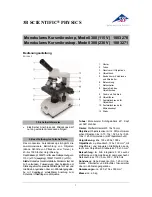
SAFETY PRECAUTIONS
•
Be sure to turn off the power to the SPM CONTROL unit in advance when
mounting or dismounting the scanner holder, specimen holder or SPM
head unit.
There is a risk of electric shock due to the high voltage applied to the connector pins
from the SPM CONTROL unit.
•
Never exchange a specimen while a high bias voltage is being applied to
the specimen.
You might get an electric shock due to the high voltage applied to the specimen.
•
When storing the instrument, avoid high humidity.
Excess humidity brings deterioration of insulation at the tunneling current detector
and scanner high-voltage circuits, causing insufficient instrument performance or
electric shock.
•
Be careful not to put your hand under the base plate.
You might get your fingers caught.
•
To avoid burns, allow the lamp to cool down for at least 30 minutes be-
fore removing it. Never touch the lamp with bare hands because it is very
hot immediately after the filament burns out.
•
When handling the instrument, be sure to wear nylon gloves.
Grease from hands may cause deterioration of the vacuum especially when you ob-
serve a specimen in the vacuum using an optional evacuation system. At the worst,
there is a risk of deterioration of insulation at the tunneling current detector and
scanner high-voltage circuits, causing insufficient instrument performance or elec-
tric shock.
If any parts happen to have hand grease on them, softly wipe it off with etha-
nol-soaked lint-free tissue or cloth.
CAUTIONS
•
Do not install this instrument in a place where any fluorescent lamps di-
rectly illuminate the SPM head.
Fluorescent lamps blink at 100 Hz (if the line frequency is 50 Hz) or at 120 Hz (if
the line frequency is 60 Hz) and this noise may appear on the displayed image.
Concerning the installation and layout plan, please consult your local JEOL service
personnel.
•
Handle the scanner holder very carefully since it is a precision device.
It could be easily damaged by a mechanical shock.
•
The bias voltage to be applied to the specimen is superposed on the
"B+" wire in the heating cable. Therefore, the heating power supply must
be electrically isolated from the ground (GND).
If one of the heating cable wires is grounded, the bias voltage circuit might be
damaged.
•
If the Sample Bias is set by using the slider during image observation, be
careful not to move the slider button across 0 V.
The tip would collide with the specimen surface if the bias voltage became 0 (zero).
S-2
TMPM5200-2












































